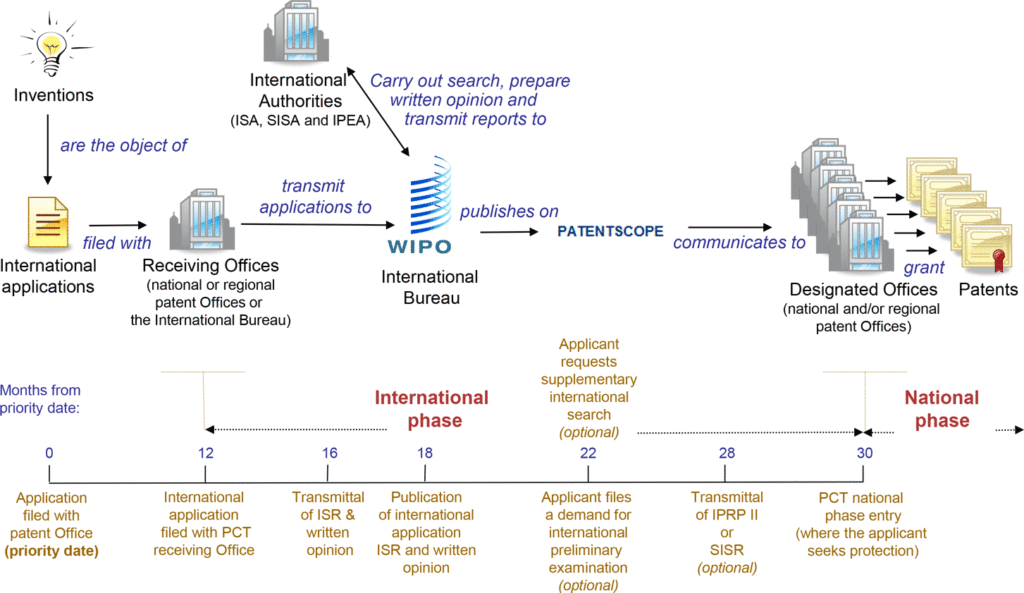The Patent Cooperation Treaty (PCT) offers a streamlined process for inventors seeking patent protection across multiple countries through a single international application. This guide provides an overview of the PCT application process in China, highlighting key procedures, benefits, and considerations for applicants.
What Is a PCT International Patent Application?
A PCT international application allows inventors to seek patent protection simultaneously in numerous countries by filing a single application. As of now, the PCT has 157 contracting states. The application process is divided into two main phases:
- International Phase: Involves filing the application, undergoing an international search, publication, and optionally, an international preliminary examination.
- National Phase: Each designated country’s patent office evaluates the application to decide on granting patent rights. See more about the guidelines for PCT entry into China.
PCT Application Procedure
- Filing: Submit an international application to a competent patent office or the World Intellectual Property Organization (WIPO), using one language and paying the required fees.
- International Search: An International Searching Authority (ISA, check out the list of ISAs) identifies prior art that may affect the patentability of your invention and provides a written opinion.
- International Publication: The application is published approximately 18 months from the earliest priority date, making the content publicly available.
- International Preliminary Examination (Optional): Upon request, an ISA conducts a further patentability analysis, typically on an amended version of the application.
- National Phase: Around 30 months from the earliest priority date, applicants enter the national phase in each country where patent protection is sought.

Protecting Your Invention in Multiple Countries
Inventors have two primary routes to secure patent protection internationally:
- Direct or Paris Route: File individual patent applications in each desired country simultaneously or within 12 months from the first application under the Paris Convention.
- PCT Route: File a single PCT application within 12 months from the initial filing, which is effective in all PCT contracting states.
Advantages and Disadvantages of PCT Applications
Advantages
- Extended Decision Period: Applicants have up to 30 months from the earliest priority date to decide on entering the national phase in various countries, which enables applicants to have an additional 18 months beyond the Paris Convention’s 12-month priority period.
- Informed Decision-Making: International search reports and written opinions provide insights into patentability, allowing for informed decisions and potential amendments before entering national phases.
Disadvantages
- Additional Costs: The international phase introduces extra fees compared to direct filings. For a limited number of target countries, the Paris route may be more cost-effective.

Fees in the International Phase
Basic Fees:
- International Filing Fee: CNY 10,920
- Search Fee: CNY 2,100
Additional Fees (If Applicable):
- Additional International Filing fee for Each Page Over 30: CNY 120
- Priority Document Fee (per priority): CNY 150
- Supplementary Search Fee: CNY 1,500
- Preliminary Examination Fee: CNY 1,500
- Handling Fee: CNY 1640
See more for the complete official fee schedule for the PCT application in China.
See more for other kinds of patent fees.
Fee Reductions:
All applicants who are individuals and nationals or residents of certain countries, including China (covering Hong Kong, Macau, and Taiwan), may qualify for a 90% reduction in international filing fees, and handling fees.
See more for the official guidelines about fee reduction.
Filing a PCT Application with CNIPA
Methods
- Electronic Filing: Utilize CNIPA’s patent online system for electronic submissions.
- Paper Filing: Submit physical documents to CNIPA’s PCT division.
Required Documents
- Request Form: Standardized form detailing applicant information.
- Description, Claims, Drawings, Abstract: Comprehensive documentation of the invention.
- Priority Documents and Power of Attorney: If applicable, submit priority documents and authorization forms.
Applicant Eligibility
For filings with CNIPA, Chinese nationals, residents, or entities qualify.
If applicants are more than one, at least one applicant must be a national or resident of China.
Language Requirements
CNIPA accepts international applications in Chinese or English.
Opportunities for Amendment During the International Phase
Applicants have two opportunities to amend their applications:
- Under PCT Article 19: After receiving the international search report, applicants may amend the claims within a specified timeframe.
- Under PCT Article 34: During the international preliminary examination, applicants can amend the description, claims, and drawings.
Further Information
See more about the WIPO’s introduction to the PCT international phase.
Considering a PCT Patent Application in China?
If you’re planning to file a PCT application through China, provide your technical disclosure or prior application documents to receive a complimentary quote. Our team has extensive experience assisting clients with PCT patent applications via CNIPA. Contact us at contact@gbaiplawyer.com for personalized assistance.

